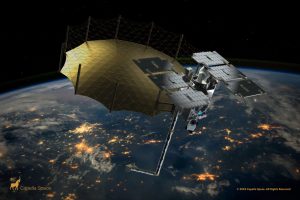Their infrastructure agreement will, they say, allow Mobile Network Operators (MNOs), device makers and chipset manufacturers to take 3GPP Release 17 compliant products to market using Viasat’s network coverage (and that of future partners). They say it will be the “world’s first global D2D network”
Initial deployments are planned for early 2024, in North America, using the Ligado SkyTerra satellite network. This will be followed by a global rollout.
IoT
As well as supporting consumer smartphone services, the new network is aimed at massive Internet of Things (IoT), automotive and defense applications.
For example, highlights Viasat, food producers, miners and logistics businesses will gain access to “enhanced connectivity experiences”, whether through cellular or satellite, without requiring proprietary satellite hardware. This should reduce end-user costs and help optimise global production and supply chains.
“The combination of the network with MNO and chipset manufacturer collaboration will provide new opportunities for Original Equipment Manufacturers (OEMs) that wish to embed connectivity into their smartphones, wearables, vehicles, machinery and other devices,” says Viasat in the announcement. “IoT solution providers stand to gain access to ubiquitous connectivity and economical hardware to scale their solutions globally.”
Customers will be able to access the services through Viasat or Skylo.
Specifically, the network will see Skylo’s Release-17-based satellite technology combining with Inmarsat’s geostationary, L-band satellite constellation and licensed spectrum holdings, as well as those of other satellite operators. Viasat acquired Inmarsat earlier this year.
Skylo D2D
“This network is available for testing today and will enable global market entry for innovators,” said Anton Monk, vp of Wireless Initiatives at Viasat.
“Building the network on L-band geostationary satellite technology means it doesn’t require special licensing of terrestrial spectrum and by utilizing the 3GPP standard there is assured interoperability, particularly as exciting new Releases follow Release 17.”
For its part, Skylo talked of an “inflection point” for connectivity.
“By merging our groundbreaking 85+ patents and 3GPP Release-17-based satellite technology with Viasat’s extensive geostationary network, spectrum capabilities and partnerships, we are unlocking a world of unprecedented connectivity,” said Tarun Gupta, CPO and Co-Founder of Skylo.
“This network is not just a technological breakthrough; it’s a catalyst for inclusive, global innovation – bringing high-quality, affordable connectivity to every corner of the planet, revolutionizing industries from agriculture to transportation, and enhancing lives in both urban and remote communities.”
Space race
Viasat, with Omnispace, has also been working with Lacuna Space for space-based IoT services. The latter demonstrated what it called a “first-of-its-kind, global, open standards-based internet of things (IoT) service”. It demonstrated the non-geostationary (NGSO) IoT satellite connectivity at September’s ‘The Things Conference‘ in Amsterdam, Netherlands.
The aim is to pave the way for a range of IoT and D2D satellite services.
And last week we reported Lockheed Martin completing a final demo of what it described as its first regenerative non-terrestrial network 5G Satellite Base Station (gNodeB). Basically, where a satellite provides signal regeneration, for bridging comms between Earth and a satellite network.
It was the final demo prior to a self-funded space mission. The plan is that, next year, the company will launch this payload to orbit to bring space-based 5G capabilities to terrestrial users.
See also: Lacuna’s IoT network to offer LoRaWAN direct-to-satellite connectivity
 Electronics Weekly Electronics Design & Components Tech News
Electronics Weekly Electronics Design & Components Tech News




